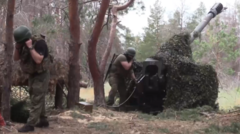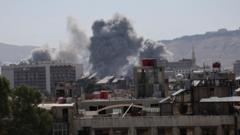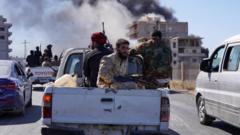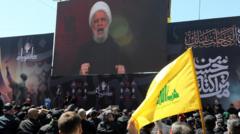Recent reports indicate that Russia's military campaign in Ukraine has met substantial resistance as it pushes to seize key territories across three fronts. While claiming limited territorial gains, the operational strategy showcases the severe toll on Russian troops and the ongoing logistical struggles faced by both sides amidst devastating drone and missile assault patterns.
Russia's Challenging Offensive in Ukraine: The Struggle for Control on Multiple Fronts

Russia's Challenging Offensive in Ukraine: The Struggle for Control on Multiple Fronts
As Russia intensifies its military actions in Ukraine, facing stiff resistance, the ongoing conflict increasingly highlights the challenges of territorial expansion amidst high casualties.
In its pursuit of dominance, Russian forces have ramped up drone and missile strikes against Ukraine, setting new records for overnight bombardments. On the ground, however, the military's claims of territorial advances are tempered by military analytics—last month, Russia purportedly took control of 556 square kilometers (around 215 square miles), the largest acquisition this year according to the DeepState monitoring website. For context, that represents an area substantially larger than Liverpool, comparable to Chicago.
The Russian military's aspirations include severing supply lines for Ukrainian troops and establishing a safe buffer zone within Ukraine's northern borders. Yet, progress has been agonizingly incremental; if the current pace continues, it could hypothetically take over 70 years for Russia to assert dominance across the entirety of Ukraine.
The focal points of Russia’s attacks include the Sumy region, bordering Russia to the northeast, the key eastern cities of Pokrovsk and Kostyantynivka, and a newly opened front west of Pokrovsk. Despite some advances into Sumy, Russian troops have faced formidable resistance, halting their progress. President Vladimir Putin's stated objective of creating a protective buffer comes after previous Ukrainian successes in capturing parts of Kursk territory.
Some experts believe such military maneuvers are strategically designed to stretch Ukraine's defensive resources thin along their lengthy 1,200-kilometer front line, forcing the redistribution of troops from critical positions. In Pokrovsk, a strategic hub that has been contested for over two years, estimates suggest 111,000 Russian troops are concentrated in the area.
Lt Artem Pribylnov, from Ukraine’s 155th brigade, describes a lack of large-scale assaults, asserting instead that Russian tactics revolve around smaller infantry engagements designed to drain Ukraine’s defenses. This method, dubbed a "creeping offensive," aims to wear down Ukrainian morale and resources, with reports of heavy Russian casualties—over 1,000 soldiers per day.
In a strategic move, Russian forces aim to encircle Ukrainian troops by creating a "cauldron" around Pokrovsk and Kostyantynivka, urging a retreat from Ukrainian lines. However, breakthroughs in achieving this are rare, with advancements already showing signs of fatigue.
Recently, there were more substantive gains for Russian forces west of Pokrovsk, particularly in the Novopavlivske region, where the momentum of attacks rose alarmingly, pushing towards a neighboring region. However, Ukrainian authorities refute claims of extensive Russian territorial control, noting that they successfully countered these advances.
Supply chains for Ukraine’s frontline troops are under strain, as ongoing drone attacks have rendered previous routes untenable. Staff Sgt Viktor Pyasetskyi reported the complexities in delivering vital supplies and logistical support under the constant threat of drone strikes from Russian capabilities.
As the conflict continues to intensify, it underscores both the human cost of warfare and the profound challenges each side faces in maintaining military efficacy amidst evolving battlefield conditions. The stark realities of combat reflect not only the strategic underpinnings of military operations but also the broader implications for Ukrainian resilience and morale against aggression.
The Russian military's aspirations include severing supply lines for Ukrainian troops and establishing a safe buffer zone within Ukraine's northern borders. Yet, progress has been agonizingly incremental; if the current pace continues, it could hypothetically take over 70 years for Russia to assert dominance across the entirety of Ukraine.
The focal points of Russia’s attacks include the Sumy region, bordering Russia to the northeast, the key eastern cities of Pokrovsk and Kostyantynivka, and a newly opened front west of Pokrovsk. Despite some advances into Sumy, Russian troops have faced formidable resistance, halting their progress. President Vladimir Putin's stated objective of creating a protective buffer comes after previous Ukrainian successes in capturing parts of Kursk territory.
Some experts believe such military maneuvers are strategically designed to stretch Ukraine's defensive resources thin along their lengthy 1,200-kilometer front line, forcing the redistribution of troops from critical positions. In Pokrovsk, a strategic hub that has been contested for over two years, estimates suggest 111,000 Russian troops are concentrated in the area.
Lt Artem Pribylnov, from Ukraine’s 155th brigade, describes a lack of large-scale assaults, asserting instead that Russian tactics revolve around smaller infantry engagements designed to drain Ukraine’s defenses. This method, dubbed a "creeping offensive," aims to wear down Ukrainian morale and resources, with reports of heavy Russian casualties—over 1,000 soldiers per day.
In a strategic move, Russian forces aim to encircle Ukrainian troops by creating a "cauldron" around Pokrovsk and Kostyantynivka, urging a retreat from Ukrainian lines. However, breakthroughs in achieving this are rare, with advancements already showing signs of fatigue.
Recently, there were more substantive gains for Russian forces west of Pokrovsk, particularly in the Novopavlivske region, where the momentum of attacks rose alarmingly, pushing towards a neighboring region. However, Ukrainian authorities refute claims of extensive Russian territorial control, noting that they successfully countered these advances.
Supply chains for Ukraine’s frontline troops are under strain, as ongoing drone attacks have rendered previous routes untenable. Staff Sgt Viktor Pyasetskyi reported the complexities in delivering vital supplies and logistical support under the constant threat of drone strikes from Russian capabilities.
As the conflict continues to intensify, it underscores both the human cost of warfare and the profound challenges each side faces in maintaining military efficacy amidst evolving battlefield conditions. The stark realities of combat reflect not only the strategic underpinnings of military operations but also the broader implications for Ukrainian resilience and morale against aggression.






















